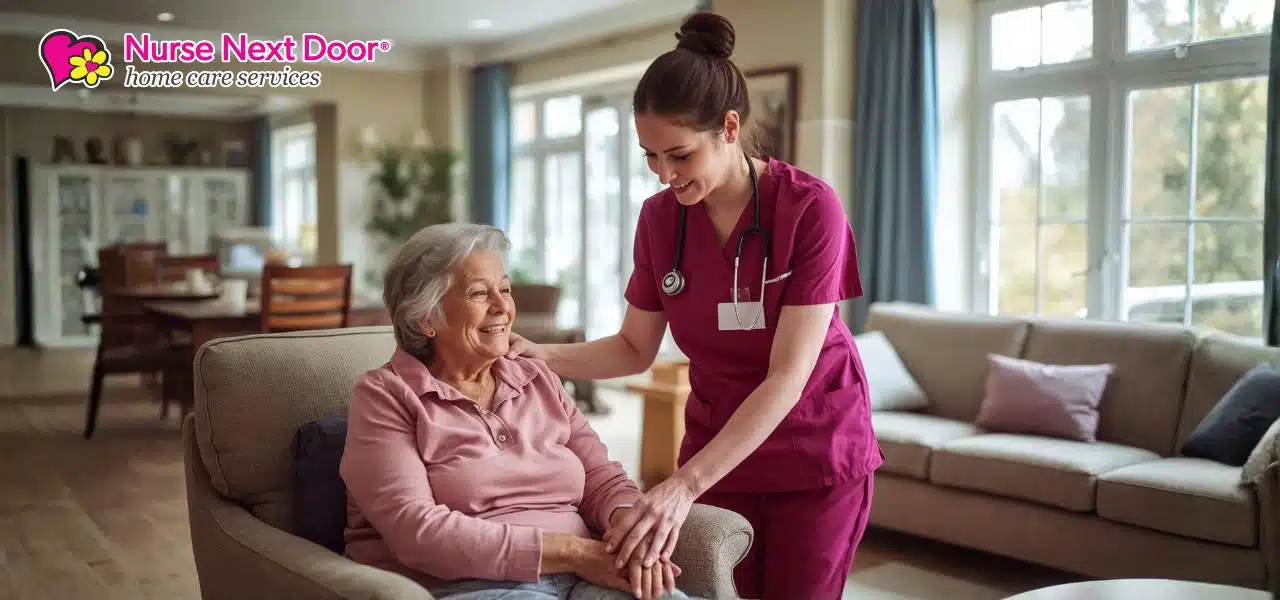
Falls are one of the biggest risks faced by people with dementia. The Centers for Disease Control and Prevention (CDC) reports that falls send around 3 million seniors to the emergency room each year – and those with dementia are more at risk than anyone else. However, falls and other risks can be minimized through quality memory care and by creating a safe home environment. Let’s break down some simple – yet effective – home modifications you can make to keep your loved one safe.
Steps to Prevent Falls at Home
First of all, consider getting rid of all throw rugs and make sure the carpets are secured – you don’t want your loved one’s foot slipping or getting caught on them. Adding some bright yellow or orange tape to the edges of stairs–both inside and outside–can also be a lifesaver. It makes the edges a lot more visible so your loved one knows exactly where one level ends and where another begins. Research in the Journal of the American Geriatrics Society actually shows that simple visual cues like brightly colored tape can make a real difference in reducing the number of falls in people with cognitive problems.
Next install some grab bars in the bathroom – one near the toilet and a few inside the shower or tub. You should also add some nonskid mats to the bathtub and bathroom floor. These simple fixes can give your loved one a lot more stability when they need it most. Nightlights in the hall and bathroom are also a good idea – they let your loved one make their way around safely at night.
Why In-Home Alzheimer’s Care in Chantilly Focuses on Establishing a Daily Routine
Keep Hazardous Materials and Objects Locked Away
Dementia can really mess with a person’s judgement and decision making. It’s important to keep hazardous materials or objects out of reach.
Lock up all the medications – including the over-the-counter ones. You should also lock down cabinets containing things like cleaning products, chemicals, and pesticides by using child-proof locks. Make sure sharp objects such as knives, scissors and razors are kept locked away in a safe place. If possible, get rid of power tools, weapons or any associated item that could be a hazard if used in the wrong way.
Steer Clear of Mirrors and Highly Reflective Surfaces
You might not expect this one but – believe it or not – mirrors can confuse people with dementia. As the disease gets worse, your loved one may start to think that a complete stranger has moved in with them, which of course makes them pretty anxious.
The same goes for highly reflective surfaces like large glass doors or really shiny floors. They can create all sorts of confusing reflections or make it seem like there’s something in the way. One solution is to cover or remove these mirrors from the bedroom and bathroom. If that’s not an option, at least put some frosted window film or a curtain on the windows to minimize the reflections.
Ensure the Home is Well Lit and Use Contrasting Colors
According to the Alzheimer’s Society, good lighting reduces confusion and increases safety in the home. Poor lighting creates shadows that your loved one might see as holes or obstacles. So, make sure every room is well lit. Avoid dim lighting or areas with big light-to-dark transitions. Use motion sensor lights in hallways and bathrooms so lights turn on when your loved one enters.
Contrasting colors help define spaces and objects. Paint door frames a different color than the walls so doorways are obvious. Use a toilet seat that contrasts with the floor so your loved one can find it easily. You can also put colored tape around light switches.
Prevent Wandering
Wandering is common in patients living with dementia and very dangerous. Your loved one might leave the house looking for a workplace they retired from decades ago or try to “go home” when they’re already home. Effective memory care means strategies to prevent unsafe wandering.
Install locks your loved one can’t operate easily–consider putting deadbolts on doors where they’re less noticeable. Also add motion sensors that alert you when doors open. Some families use door alarms that chime when activated.
If your loved one spends time outside, make sure the yard is fenced. Create a clear safe path for them to follow. Remove or lock up hoses, rakes and other outdoor hazards. Consider camouflaging exit doors with curtains or wall hangings or putting “STOP” signs on doors to discourage exit attempts.
How In-Home Alzheimer’s Care Manages Difficult Behaviors
Find a Reliable Caregiver to Keep the Mind Sharp and Ensure Safety
Even with all these changes, your loved one still needs ongoing supervision and engagement. That’s where memory care comes in.
Nurse Next Door McLean provides Alzheimer’s and dementia care in your loved one’s modified home. Our caregivers know how dementia affects daily life and how to work within your home’s new safety features to provide the best possible memory care.
We create personalized care plans that include cognitive stimulation activities, medication reminders, meal preparation, and safety monitoring. Our caregivers can spot potential hazards, suggest additional modifications and adapt as your loved one’s needs change. Plus, with our 24/7 support and flexible scheduling, we’re always at your beck and call.
Conclusion
Modifying your home for memory care keeps your loved one safer and makes them more comfortable. With professional in-home care, these modifications allow your loved one to age in place with dignity.
Ready to get started? Book a free Caring Consult and learn how our dementia care services can help your family.



